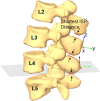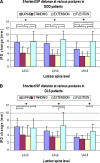Motion characteristics of the lumbar spinous processes with degenerative disc disease and degenerative spondylolisthesis
- PMID: 23903997
- PMCID: PMC3843791
- DOI: 10.1007/s00586-013-2918-y
Motion characteristics of the lumbar spinous processes with degenerative disc disease and degenerative spondylolisthesis
Abstract
Objective: Recently, interspinous process devices have attracted much attention since they can be implanted between the lumbar spinous processes (LSP) of patients with degenerative disc disease (DDD) and degenerative spondylolisthesis (DLS) using a minimally invasive manner. However, the motion characters of the LSP in the DLS and DDD patients have not been reported. This study is aimed at investigating the kinematics of the lumbar spinous processes in patients with DLS and DDD.
Methods: Ten patients with DDD at L4-S1 and ten patients with DLS at L4-L5 were studied. The positions of the vertebrae (L2-L5) at supine, standing, 45° trunk flexion, and maximal extension positions were determined using MRI-based models and dual fluoroscopic images. The shortest ISP distances were measured and compared with those of healthy subjects that have been previously reported.
Results: The shortest distance of the interspinous processes (ISP) gradually decreased from healthy subjects to DDD and to DLS patients when measured in the supine, standing, and extension positions. During supine-standing and flexion-extension activities, the changes in the shortest ISP distances in DDD patients were 2 ± 1.2 and 4.8 ± 2.1 mm at L4-L5; in DLS patients they were 0.5 ± 0.4 and 2.8 ± 1.7 mm at L4-L5, respectively. The range of motion is increased in DDD patients but decreased in DLS patients when compared with those of the healthy subjects. No significantly different changes were detected at L2-L3 and L3-L4 levels.
Conclusion: At the involved level, the hypermobility of the LSP was seen in DDD and hypomobility of the LSP in DLS patients. The data may be instrumental for improving ISP surgeries that are aimed at reducing post-operative complications such as bony fracture and device dislocations.
Figures





Similar articles
-
Lumbar facet joint motion in patients with degenerative spondylolisthesis.J Spinal Disord Tech. 2013 Feb;26(1):E19-27. doi: 10.1097/BSD.0b013e31827a254f. J Spinal Disord Tech. 2013. PMID: 23168388 Free PMC article.
-
Kinematic analysis of diseased and adjacent segments in degenerative lumbar spondylolisthesis.Spine J. 2015 Feb 1;15(2):230-7. doi: 10.1016/j.spinee.2014.08.453. Epub 2014 Sep 8. Spine J. 2015. PMID: 25220670
-
Lumbar facet joint motion in patients with degenerative disc disease at affected and adjacent levels: an in vivo biomechanical study.Spine (Phila Pa 1976). 2011 May 1;36(10):E629-37. doi: 10.1097/BRS.0b013e3181faaef7. Spine (Phila Pa 1976). 2011. PMID: 21270686 Free PMC article.
-
[Development research of in vivo kinematics in lumbar degenerative spondylolisthesis].Zhongguo Xiu Fu Chong Jian Wai Ke Za Zhi. 2014 Dec;28(12):1555-9. Zhongguo Xiu Fu Chong Jian Wai Ke Za Zhi. 2014. PMID: 25826906 Review. Chinese.
-
Instability in spondylolisthesis.Orthopedics. 1991 Apr;14(4):463-5. doi: 10.3928/0147-7447-19910401-11. Orthopedics. 1991. PMID: 2038581 Review.
Cited by
-
Psychosocial and Motor Characteristics of Patients With Hypermobility.Front Psychiatry. 2022 Mar 28;12:787822. doi: 10.3389/fpsyt.2021.787822. eCollection 2021. Front Psychiatry. 2022. PMID: 35418881 Free PMC article.
-
Kinematic characteristics of lumbar spinous processes during axial rotation in patients with lumbar degenerative disc disease lateral lumbar interbody fusion and intervention.BMC Musculoskelet Disord. 2017 Apr 4;18(1):141. doi: 10.1186/s12891-017-1504-6. BMC Musculoskelet Disord. 2017. PMID: 28376780 Free PMC article.
-
Comparison of intra subject repeatability of quantitative fluoroscopy and static radiography in the measurement of lumbar intervertebral flexion translation.Sci Rep. 2019 Dec 17;9(1):19253. doi: 10.1038/s41598-019-55905-1. Sci Rep. 2019. PMID: 31848427 Free PMC article. Clinical Trial.
-
Study of mechanical effects of lumbar disc arthroplasty on facet joints at the index level/adjacent levels by using a validated finite element analysis.Front Bioeng Biotechnol. 2023 Nov 21;11:1287197. doi: 10.3389/fbioe.2023.1287197. eCollection 2023. Front Bioeng Biotechnol. 2023. PMID: 38076418 Free PMC article.
-
Development of a morphology-based modeling technique for tracking solid-body displacements: examining the reliability of a potential MRI-only approach for joint kinematics assessment.BMC Med Imaging. 2016 May 18;16(1):38. doi: 10.1186/s12880-016-0140-1. BMC Med Imaging. 2016. PMID: 27189195 Free PMC article.
References
Publication types
MeSH terms
Grants and funding
LinkOut - more resources
Full Text Sources
Other Literature Sources
Medical
Research Materials

